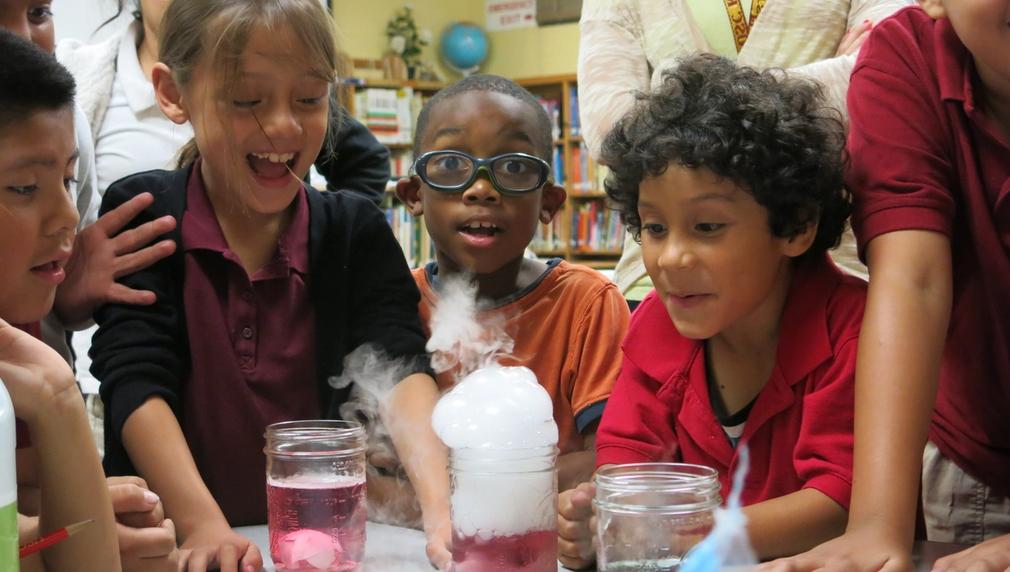USC JEP STEM Education Program Expansion
The USC Joint Educational Project's STEM Education Programs deliver hands-on, inquiry-based Science, Technology, Engineering, and Math (STEM) outreach directly to low-income students of color and their teachers in classrooms. Our programs aim to address the science education needs of our JEP partner schools by enlisting STEM undergraduate and graduate students as Teaching Assistants (TAs) to provide free STEM programming in Title 1 schools.

What is the primary issue area that your application will impact?
K-12 STEAM education
In what stage of innovation is this project, program, or initiative?
Expand existing project, program, or initiative (expanding and continuing ongoing, successful work)
What is your understanding of the issue that you are seeking to address?
Research has indicated that when elementary school students are exposed early to STEM education that this will positively impact their perception of the topic. However, there is currently a lack of STEM-based curricula for elementary school teachers and consequently, less access to quality STEM instruction for students around the country. Many elementary school teachers lack the pedagogical expertise in STEM concepts including scientific inquiry and technological design to translate them into tangible hands-on based lessons and therefore tend not to use STEM-heavy curricula with their students. As a result science instructional time is declining in elementary schools and students are less frequently given a spark for science and tend to have lower achievements in science. However, by introducing early grade elementary school students to a STEM-integrated curriculum based on interactive problem solving activities, interest in STEM career fields increases.
Describe the project, program, or initiative this grant will support to address the issue.
The JEP STEM curriculum functions as an effective supplement of current science instruction in Los Angeles Unified School District (LAUSD) schools. It incorporates Next Generation Science Standards (NGSS), as well as LAUSD and statewide grade-level science learning standards, with the ultimate goal of strengthening science literacy and promoting interest in scientific careers. JEP STEM's primary objectives are to present accessible and engaging science lessons to the neighborhood children around the university, assist in alleviating the fear and stress that is often associated with studying science, and help students apply what they learn in the classroom to the real world and to their own lives. In addition to the myriad positive benefits of JEP STEM for the neighborhood schools and students, JEP STEM teaching assistants receive valuable opportunities and professional training to hone their mentorship skills and gain practical teaching experience, allowing them to be more informed about how to directly respond to the individual needs of the schools, communities and families. We are currently offering 2nd through 5th grade at 7 schools, and funding from LA2050 would allow us to expand so that we could be Kindergarten through Fifth grade at all of our partner schools which would increase our impact by 1680 students.
Describe how Los Angeles County will be different if your work is successful.
Our vision for the USC JEP STEM is to create a sustainable, impactful initiative that transforms LA County by improving STEM education in underserved communities. We aim to engage K-12 students with hands-on learning, support teachers with professional development & resources, & foster critical thinking & collaboration skills in students. Long-term, we plan to expand to more schools, develop scalable models, & create a digital platform for remote learning.
Community involvement will be enhanced through partnerships and events, while impact measurement will ensure continuous improvement. Our goals include bridging educational gaps, contributing to a diverse STEM workforce, & empowering students to make societal contributions.
By focusing on these areas, the JEP STEM will make LA County a hub of STEM excellence, with higher student engagement, improved academic performance, & a skilled workforce driving innovation & progress, enriching the region's educational & economic landscape.
What evidence do you have that this project, program, or initiative is or will be successful, and how will you define and measure success?
We measure the impact of our STEM Programs using both quantitative & qualitative methods. Feedback is collected from teachers, staff, students, & parents through Google Forms, worksheets, & surveys. Teachers & staff provide feedback on the program, staff, & curriculum, which we use to make improvements. For elementary students, we assess STEM content learning through pre- & post-tests, & measure science interest and scientific identity through science interest surveys & "Draw a Scientist" tests. Evidence of our program's effectiveness includes improved test scores, increased interest in STEM fields, and positive feedback from stakeholders. Post-test results show significant gains in STEM knowledge, surveys indicate heightened interest in STEM activities, & qualitative feedback highlights improvements in students' attitudes toward science. By continuously collecting & analyzing this data, we ensure our program effectively addresses STEM educational gaps in Los Angeles County.
Approximately how many people will be impacted by this project, program, or initiative?
Direct Impact: 2,750.0
Indirect Impact: 4,000.0